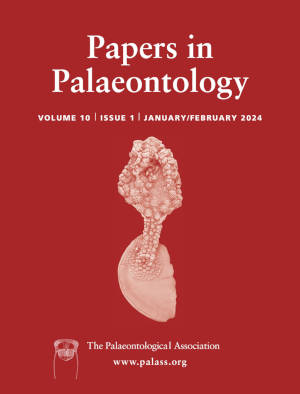Article: Pleurotomariida (Gastropoda) from the upper Anisian platform carbonates of the Dolomites (Southern Alps, Italy): systematics, palaeobiogeography and Triassic recovery
Publication: Papers in Palaeontology
Volume:
10
Part:
2
Publication Date:
2024
Article number:
e1545
Author(s):
Stefano Monari, and Elio Dellantonio
DOI:
10.1002/spp2.1545
Abstract
Abstract A very rich gastropod fauna from the upper Anisian (Nevadites secedensis Zone) platform carbonates of the Dolomites, represented by more than 200 species, was collected over recent decades. Its study contributes to a better understanding of the dynamics of the recovery after the end-Permian mass extinction. This paper deals with the Pleurotomariida. A total of 35 species, 22 genera and 9 families have been identified. Of these, 12 species and 7 genera are new, namely Rufilla wilckensi sp. nov., Rufilla giacomellii sp. nov., Viezzenella ruvida gen. et sp. nov., Temnotropis maestroettorei sp. nov., Cancellotomaria boninsegnai sp. nov., Stuorella crenulata sp. nov., Codinella? fontanai sp. nov., Fiacconella pericincta gen. et sp. nov., Fiemmespira gen. nov., Texturaspira gen. nov., Nodocingulum ogilvieae sp. nov., Dimorphotomaria fassaensis gen. et sp. nov., Moenaspira crassa gen. et sp. nov. and Predazzella elongata gen. et sp. nov. Comparison with the gastropod fauna of the St Cassian Formation indicates that, from the late Anisian to the Carnian, in the Dolomites the richness of the Pleurotomariida increased by 54% at species level, 26% at genus level and 22% at family level. A comprehensive palaeobiogeographical analysis highlights a very high degree of endemism: 90% of the species are exclusive to single palaeogeographical units. This suggests that species diversification at a strict local scale was a major feature of the Middle Triassic phase of recovery of the Pleurotomariida. Seemingly, the non-planktotrophic development of this group combined with a patchy resurgence of the carbonate platforms played an important role in hampering dispersal.
